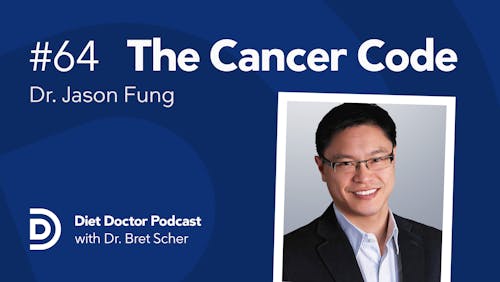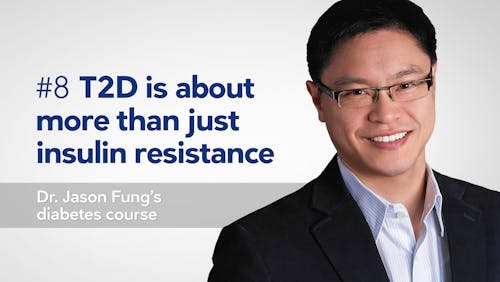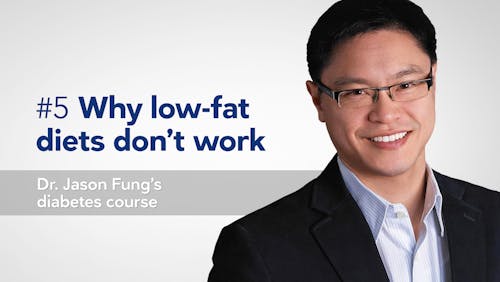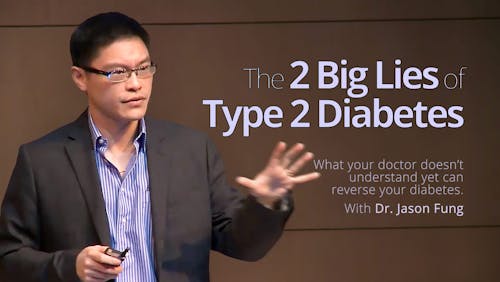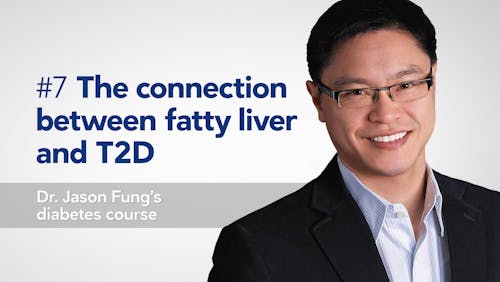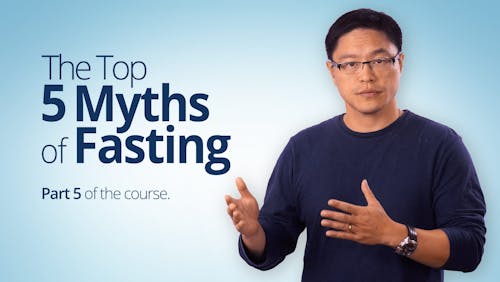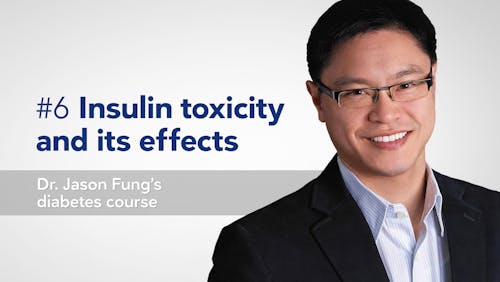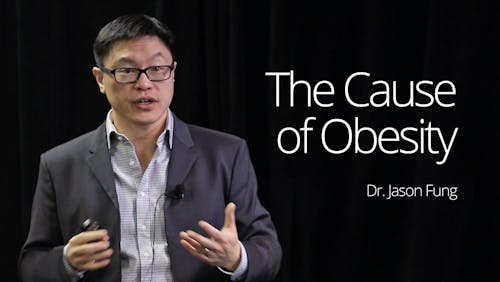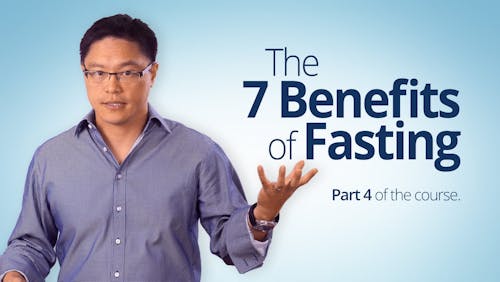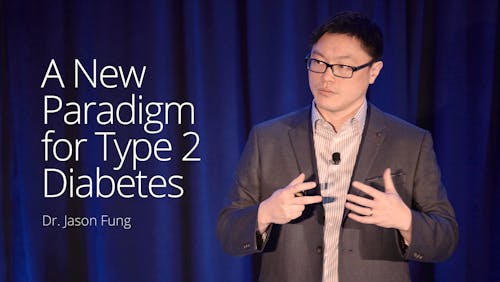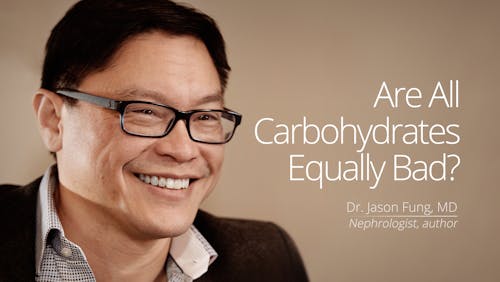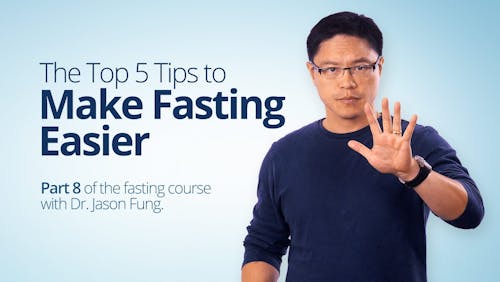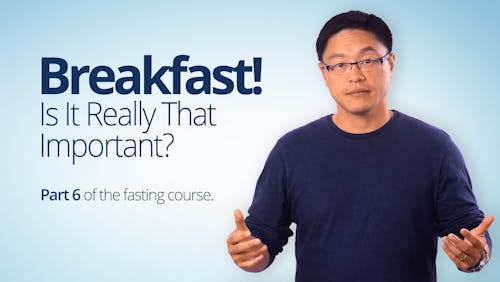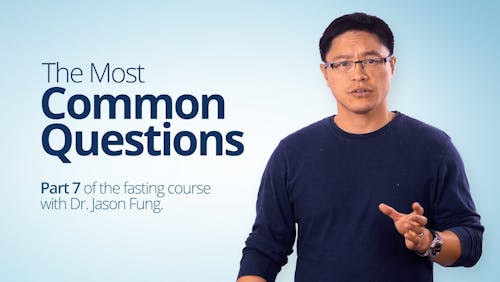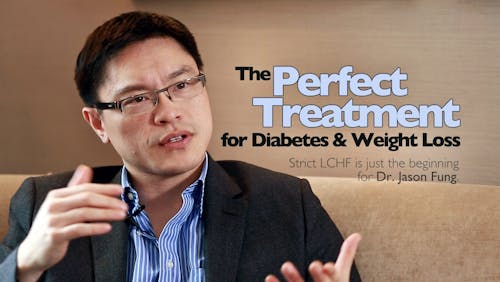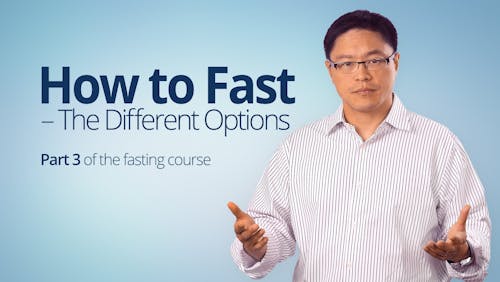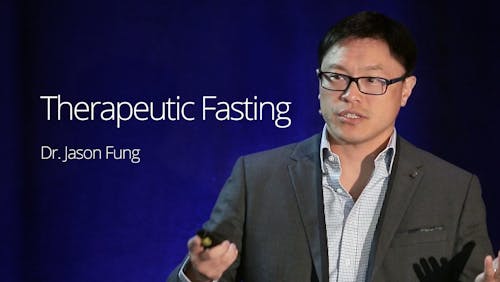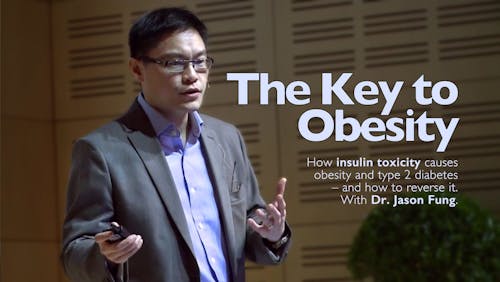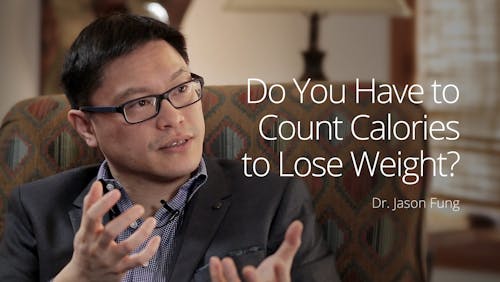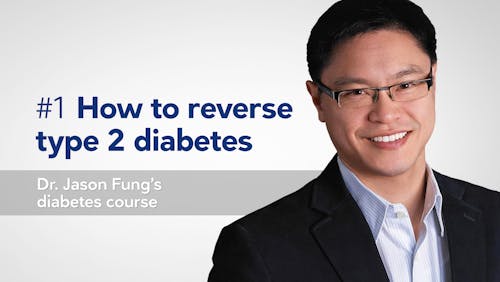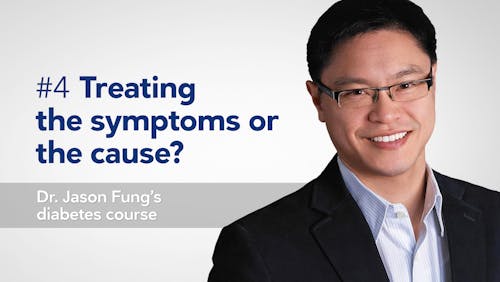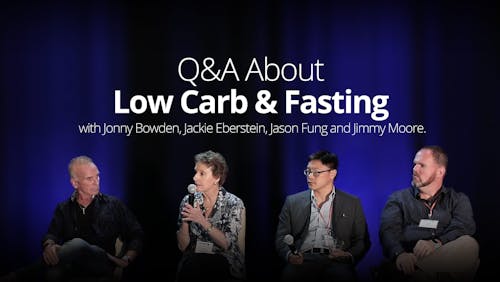2,656 views Add as favorite
Table of contents
0:40 The two phases of type 2 diabetes
4:00 What is insulin resistance?
13:10 What causes fatty liver?
19:05 Beta cell dysfunction burnout
22:05 The sugar bowl
29:00 How to reverse type 2 diabetes
33:25 Dietary regimens
39:57 Medication adjustments
47:01 Bloodwork
52:40 Questions
Transcript
Dr. Jason Fung: Thanks very much, so what I thought I’d do is I’m going to go over very quickly… the insulin resistance and the way to think about type 2 diabetes particularly and then leave some time for questions and also some discussion about adjustment in medications and so on, which I don’t really discuss because I don’t ever like to have this out, so I don’t like people to try and do it themselves.
So that’s fine, but is limited to health professionals. So the thing about type 2 diabetes is that I think that we think about it all in the wrong manner. So what is it? It’s a disease of the elevated insulin resistance, but there’s actually two phases to it. So type 2 diabetes actually falls into a kind of a phase 1 and a phase 2. So this is the Whitehall Study where they look at the blood glucose kind of in the years prior to diagnosis.
And what you can see is that by the time you diagnose type 2 diabetes, you’ve actually had it for a long time. So even up to 13, 14 years before the blood glucose starts to go up. Now as the blood glucose starts to go up, what happens is that the pancreas starts to produce more insulin and that keeps the blood glucose relatively stable. So even up to two years before, you can see the fasting glucose is less than 6, which is not bad.
For the most part it would be very difficult to see, but compared to the normal control group, you can see they maintain a very stable sort of blood glucose. And then something happens, that is the pancreas which is overproducing all this insulin eventually reaches its limit and it can no longer keep up with the insulin resistance and it starts to shut down. So as it shuts down what you can see is that the blood glucose goes up.
So a lot of people say it’s the high blood glucose that kills off the pancreas. Well, that’s obviously wrong, because you can see that your blood glucose doesn’t go up until after the pancreas fails. So it can’t be that the blood glucose here at the end is killing your pancreas because it doesn’t ever go up. All that time before that, the blood glucose is pretty well fine.
So that’s one of the things that is kind of a misunderstanding that it’s all about the high blood glucose. And really it’s about the elevated insulin resistance. So the two phases of type 2 diabetes leading up to the diagnosis of type 2 diabetes really is the first phase of insulin resistance.
As you go through the spectrum of obesity to prediabetes, to diabetes, what you can see is that the fasting insulin which is a reflection of insulin resistance is going up. So this first phase in the back where you go from kind of 13 years to 2 years, is increasing insulin resistance, which is compensated by the hyperinsulinemia. As you go through that spectrum again, what you see in the black is the insulin production and the white circles is the blood glucose.
So you can see that as you become obese and prediabetic the insulin goes way up more than your blood glucose, because that’s what’s keeping the blood glucose down. So that’s those ones. But as you become type 2 diabetic– so those are the two years prior to the diagnosis, which you can see it starts to fall off because the black circle kind of goes down sort of from here to here. The insulin level is still high, but it’s not as high.
And it’s really the failure of the pancreatic beta cell that is leading to the high blood glucose because it is no longer providing that compensation. And that’s where you get that second phase where the blood glucose really just shoots up. So that’s really the pancreatic beta cell failure. So there’s two phases. And what classically has been taught is that this is due to kind of burnout, that is the pancreas burns out and therefore it fails and so on.
And that is almost certainly wrong because the problem with that is that you have type 2 diabetes now in a lot of kids. So you have 10-year-olds with type 2 diabetes. If you look at the prevalence in pediatric centers of diabetes clinics, type 1 used to be like 95% of the diabetic clinic. It’s 50-50 now. So 50% of the people in a pediatric diabetic center are type 2s.
Now it’s very hard to say that these 10, 12-year-olds that have type 2 diabetes have burned anything out, like nothing on their body has burned out. So it’s really… for sure it’s wrong. And that’s what we have to try and understand. What is leading to the pancreatic beta cell failure? Because you have to understand that. So what is insulin resistance?
This is really the new paradigm. So you got to understand that in physiology what happens is that you eat food and you increase insulin. Insulin is the signal for our body to store food energy. That’s natural, that’s normal; so you eat, insulin goes up, your body stores food energy. You produce glycogen in the liver or you turn it into fat, which is de novo lipogenesis, you store body fat.
So you store sugar and fat and as you don’t eat, as you fast, insulin levels drop and again that’s the signal to start pulling back out that food energy, that glycogen. You break down the glycogen and if you don’t have that then you’ll break down your fat cells which is lipolysis. So insulin for example turns on lipolysis, you burn fat and glycogenolysis which is breakdown of gycogen.
So this is a natural cycle and that’s the reason you don’t die in your sleep every single night, is because you have stored energy and you don’t need to keep pumping it in your body to do that. So insulin actually does two things. So not only does it put the glucose into the cell, which is the normal function that we think about, but it also turns on this kind of stores, so it turns on de novo lipogenesis. So you’re going to store energy as your insulin goes up.
Now if you say you’re insulin resistant then you should be resistant to both of those. And for sure number one works because the glucose isn’t going into the cell and you see it in the blood. But it’s not true for the de novo lipogenesis. And this is the sort of locking key mechanism that we talk about. So insulin is like a key. It turns the lock which is the insulin receptor and then glucose is able to enter the cell and go inside.
During insulin resistance what we see is that the glucose is on the outside and we say there’s something gumming up this mechanism. So if you take type 2 diabetics and you look at their insulin or you look at their insulin receptors, you can see that they’re demonstrably normal. There’s nothing wrong with that lock and there’s nothing wrong with the key.
But for some reason the key doesn’t fit the lock, maybe there’s a piece of gum inside the lock and it’s jamming it up. And that leads to a state of so-called internal starvation, because there’s no glucose in there. So the body then produces more insulin to kind of overcome that resistance, to really force that in and this is the so-called internal starvation.
And that’s the problem of course is that if you have internal starvation you should not be able to drive fat storage and new fat production. Because how are you going to produce fat from glucose when there is no glucose? That should be impossible. It’s like trying to build a house with no bricks. You can have construction workers and so on, but if you don’t have glucose you can’t make fat, if you don’t have bricks you can’t make your house.
So this is what internal starvation looks like. So type 1 diabetes, this is untreated type 1 diabetes on the left, and what you can see is that there’s zero insulin so that the glucose can’t go in and your body does waste away, no matter what you eat your body does waste away. That’s internal starvation. And then you give them insulin and this is what happens. Now we are saying that the same thing happens in type 2 diabetes, except the mechanism is different.
That is the glucose still can’t go in. But does this look like internal starvation? This is type 2 diabetes and we’ve all seen this. Visceral adiposity, big fatty liver, fats… You know, your organs are just swimming around in fat. That doesn’t really sound like or look like internal starvation. Yet we say it’s the same thing. So this is really the central paradox of this locking key mechanism and as long as you believe the locking key mechanism you’ll be doomed to failure.
Because what we’re saying is that okay so you’re resistant to the entry of glucose into cells, but yet at the same time we know in type 2 diabetes de novo lipogenesis is going on like crazy. There’s tons of fat in the liver, there’s tons of fat all over the place, you know VLDL, triglyceride levels are very high. So you’re not actually resistant to insulin at all. In fact this function of insulin is way overexpressed.
So if you have a locking key mechanism, then how can you say the very same cell, the very same insulin receptor and the very same insulin levels, which are seen by the liver, one effect is resistant and one effect is supersensitive? Obviously you’ve got the wrong kind of way to think about it. So this is– you think about your liver like a balloon for example.
If you take in food, insulin goes up, you store it, insulin goes down, you push it away. And under conditions of if you have too much insulin all the time, that is you’re pushing all this sugar into the liver all the time. What you get is a liver that’s just full. So this is really what is causing the insulin resistance. Because it’s not a failed locking key, it’s more of an overflow mechanism. Because if you have a giant fatty liver, even though you have the insulin levels you can’t push it in because it’s a lot harder.
But at the same time what’s happening is that your liver is trying to decompress itself by producing all this excess glucose into fat and just shoving it out. So this explains the central paradox of the insulin resistance. It’s not insulin resistant and insulin supersensitive at the same time in the same cell with the same molecules, like that’s just dumb. You can’t really think that that’s correct because it’s not. It’s not resistant at all, it’s really just overfilled.
That’s why one mechanism of insulin is being blocked and one mechanism it’s being accelerated. So we can see that the fatty liver– so if you have a giant fatty liver, that’s going to be resistant because it’s not a blocked lock, it’s really just an overfilled vessel. So you can see that fatty liver precedes the diagnosis of type 2 diabetes. We know that fatty liver and type 2 diabetes go together all the time. It’s virtually always that you see this.
And what you see is if you look… and this is from that same study, at the 18 months prior to diagnosis of type 2 diabetes what you can see is that the ALT levels slowly go up. the patients who didn’t have type 2 diabetes didn’t have that same problem. And so this again is not the effect of the diabetes because it precedes the diagnosis of the diabetes.
So it’s really this overflow phenomenon. So when we look at the liver cell, the hepatocyte, what you see is that it’s kind of like when you fill up your suitcase. If it’s empty, it’s really easy to put all that glucose inside. But once it fills up, it’s really hard to keep shoving in that glucose. It’s going to take more and more force to shove that into the cell. And it’s not because there’s anything wrong with the suitcase or your T-shirt. It’s that is just full.
That’s the whole problem. So just like a subway car, what you’re doing is, imagine the cell, the hepatocyte, is like a train. So what you say is that insulin opens the doors and normally when it opens the doors the glucose which is standing on the platform goes in. So now you say, well this is what happened the train pulled in, the doors opened and then none of the passengers could get in. So obviously we’re resistant to insulin, insulin didn’t work, the doors didn’t open.
But that’s not the case at all. The doors did open but the train was already full so you can’t push it in, the insulin can’t push it in. So what do we do? Well, we go to Dr. Unwin and he gives a prescription (like 10 years ago) for insulin. We get a prescription for insulin to really shove more glucose into this overstuffed glucose cell. And at some point it stops working so they come to me and I give them more insulin.
That’s not the correct thing. You’ve done exactly the wrong thing because what you need to do is empty out that cell. It’s not internal starvation, it’s an overflow phenomenon. And once you understand that, then you can understand why it works. So the key to all this is the big fatty liver because what you’re trying to do… insulin is trying to shove more fat into a big fatty liver. So you see that alcohol does very similar things but you get it with glucose and fructose as well. And we know how to cause fatty liver in a goose for example.
You just shove a tube down and you give it all this cornstarch, corn mash. We can do the same thing for humans too. If you give them a lot of sugar, a lot of glucose, you can actually produce fatty liver. And what’s fascinating about this is that you can do this study. So they did one where they overfed a group of healthy volunteers 1,000 calories of excess glucose and fructose, sugar. So two cans of soda, a little bag of candy and that was an extra 1,000 calories.
And what they found was that over a few weeks the body weight only went up by 2% but the liver fat went up by like 27%. Paralleled by the rise in de novo lipogenesis. Because you’re taking that extra glucose and fructose and you’re turning it into fat through de novo lipogenesis. So therefore it’s very easy to cause fatty liver. It’s just a matter of excess glucose and fructose. Glucose and fructose is really sugar, table sugar, sucrose.
And what’s encouraging is that if you take those same patients and you simply go back to a normal diet, once again what happens is that the body weight falls a fairly insignificant 3%, 4%, but the liver fat falls like 30%. So it’s a reversible process and that’s the important thing to understand.
So if you look at what drives really obesity it’s the hyperinsulinemia, but it’s a vicious cycle because you have a lot of glucose, of refined carbohydrates, it causes high insulin, which causes fatty liver, which causes insulin resistance, which causes more insulin resistance. So this is a vicious cycle because what’s happening is that you’re developing more insulin resistance, your body is producing more insulin which is now just driving more glucose into that fatty liver, which is going to cause more insulin resistance.
So it’s not going to work and I don’t know why would we ever think it would work, but this is what the body does. It’s similar to antibiotic resistance. So if you didn’t know any better, if you had an antibody antibiotic and the bacteria become resistant you’d say, “I’m going to use a double dose of the antibiotic because I need to overcome this resistance.”
That will work at first but then what will happen is you get more resistance and then you’ll use four times the dose and eight times the dose. In the end that higher dose is simply going to lead to more resistance. Which is exactly the wrong thing. So now we understand this with antibiotic resistance that the key is not using more antibiotics, it’s using less antibiotics. But everybody’s knee-jerk reaction is to give more.
So that’s the problem the main problem with fructose is it directly feeds into this fatty liver. It’s a completely different pathway that you can’t see if you just look at blood glucose, because remember, fructose has a sort of zero effect on your blood glucose. Because it’s fructose, there’s no glucose in there. So you take fructose, your blood sugar doesn’t go up at all. And neither does your insulin really because your blood glucose doesn’t go up.
So everybody at first thought that fructose is not so bad for you. But it’s actually really, really bad for you because the thing about glucose is that all your cells in your body can use glucose. So glucose and fructose are both going to contribute to this paradigm of insulin resistance, hyperinsulinemia, insulin resistance.
But if you take sugar… is equal parts glucose and fructose. So you eat a pound of sugar, it’s half a pound of fructose and half a pound of glucose. That glucose is dispersed through your whole body. So if you weigh 170 pounds then 170 pounds of your body is using glucose. That fructose is all going straight to your liver, which may weigh 5 pounds. And all of it is getting turned into fat. Because your body has only a certain number of things it can do with that fructose.
You can turn it into glucose, but why would you? You have tons of glucose. So the only other pathway is to turn it into fat. So all the fructose goes directly into fat but the effect is much, much higher because instead of 170 pounds of your body dispersing this glucose load, you have this poor liver that’s trying to deal with the equal amount of fructose at 5 pounds.
So the effect on your insulin resistance is like 20 or 30 times higher than the equivalent amount of glucose which you get in bread, potatoes or whatever. The fructose is much, much, much more dangerous to you. In fact that’s what all the studies show. The problem of course is that glucose and fructose which is the fatty liver, which is the insulin resistance, is really we’re talking about sucrose.
And that’s why Gary Taubes talked about the case against sugar and why you see all these kind of traditional societies, even though they had lots of carbohydrate even if they had lots of carbohydrate, you don’t see a lot of disease until you start getting sugar and fructose.
Yes, there is natural fructose in fruit but we’re talking about much higher levels of consumption of fructose in the kind of modern societies compared to say China in the 1980s, where the sugar consumption was kind of zero. So that’s insulin resistance, but what about this pancreatic burnout? Because if the beta cell is completely burned out, then there’s no chance of reversal. And that’s what we as physicians get taught.
That, “Hey if you have type 2 diabetes, your pancreas is burned out too bad, you got it for the rest of your life.” Again that is almost certainly untrue because if it was true, you wouldn’t be able to have graphs like this, which is a graph of bariatric surgery. So you can see if you do bariatric surgery that the weight comes down, that’s the graph down here.
But then you can see that the number of diabetic medication goes down very significantly, very quickly and stays down for over a year. So you go from kind of three medications down to like… a lot of people are off their medication. As opposed to medical therapy which is the graph on the top, which is really getting no effect. So that pancreatic beta cell is burned out then how does this happen?
Not only have you reversed a lot of this diabetes, you’ve reversed it very quickly in a very short period of time. Gastric banding shows the same effect so within three months or three weeks in this case, your sugars go back to normal. Like you could have diabetes for 20 years and be off of all your medications in three weeks, like that’s crazy. It means that there is a huge reversible component to it and we’ve all been taught the opposite that is not reversible.
But it’s actually not true. We’ve proved it over and over again that it’s not true. Fasting does very much the same thing. So they compared ultra low-calorie diets to fasting and what you find is that fasting does actually a much better job at weight loss. So comparing the diet versus surgery, the diet which is the blue bar have much higher levels of weight loss and in terms of blood glucose you have much lower levels of blood glucose, compared immediately postoperatively.
And what you can show is that the pancreatic fat content can actually decrease. So Dr. Roy Taylor in the UK has done a lot of this work and what he shows is that as you go to ultra low-calorie diets, you can actually reduce the pancreatic fat content. So that’s the pancreatic triglyceride content. It takes a little bit longer but by two weeks, for weeks, eight weeks, you can see if there’s a steady decline in the pancreatic fat accompanied with a restoration of the pancreatic function, the beta cell function.
Remember, if it’s burned out then it doesn’t get better, but this is the insulin response. So remember, the beta cell is producing insulin and we’re saying that it’s burned out. But it’s not because in eight weeks what happens is that bad beta cell recovers. So it’s reversible, the fatty liver has to do with the insulin resistance, but the beta cell also has complete reversibility as well.
And really what you have to understand is that it’s really not burned out, it’s really just clogged with fat, because all that triglycerides in that fatty pancreas are clogged up. And one of the things that is important is that this explains perfectly why it’s the same pathophysiology. If you think about what causes type 2 diabetes is really two things: insulin resistance and beta cell dysfunction.
What we said is that the beta cell dysfunction, if you don’t treat it, it almost always follows the insulin resistance and you almost never get the beta cell dysfunction for any other reason other than that. Yet they are caused by two entirely different things. What I’m saying is that they’re not caused by two entirely different things. They’re really caused by the same thing. And that’s the problem solving logic called Occam’s Razor.
That is the theory with the least amount of assumptions is most likely correct. Because what we’re saying is that these organs are not dysfunctional, because of any other reason like burnout, or or inflammation or this or that. Really we’re saying that the dysfunction of these organs is all related to fatty infiltration. That’s the underlying pathophysiology of that. And the reason is important to understand that it’s all due to fatty infiltration.
So fatty liver causes the insulin resistance, phase 2 is fatty infiltration of pancreas which causes the beta cell burnout. But it’s the same basic physiology. The reason that’s important to understand is that now you can understand how to treat it. Because if the problem is glucose and fructose, then the answer stares at you in the face. Just reduce it, get rid of all that glucose and fructose. That’s the whole point.
Don’t look at what kind of drugs you need to give to reverse the diabetes. Look at the cause of the diabetes and reverse that. So you can think of your body really as a big sugar bowl and over time if you eat a lot of processed foods and added sugars your body kind of fills up with sugar. So what happens eventually is that as you eat the sugar bowl is full and it spills out in the blood.
But the insulin doesn’t actually get rid of that sugar. I used to prescribe insulin a lot. Well what happens when I give patients insulin? Well, that sugar doesn’t go away. We simply take that sugar from the blood and ram it back into our body. And it’ll send it out to the kidneys, to the eyes, it will turn it into fat and the very same thing will happen the very next time they eat.
That sugar bowl is still full. You eat, sugar spills out, you take your insulin at nighttime, ram it back into your body so it’s not in the blood and it just goes on and on. Eventually the body kind of fills up with sugar that insulin is not strong enough to pump any more in, because remember it’s an overflow situation, it’s like that overfilled luggage.
You keep pushing it in, pushing it in, pushing it in and eventually you can’t push hard enough. So what do you do? Well, you get a second person to help pushing it in. So you double the dose of insulin and that works for a while, but then you keep going and going and going and that’s the problem. You had the wrong solution. So no matter how hard you go on that solution, you’re not going to get there.
What we should have done is empty it out instead of pushing more in. It was the wrong solution. So all that sugar just goes into your body, goes into your body, goes into your body, and over decades what eventually happens is that the entire body just starts to rot. Because your kidneys go, your eyes go, your toes go, you get diabetic foot ulcers, you get infections because there’s sugar everywhere and the bacteria love all that sugar.
Your whole body just starts to rot, every single part of your body starts to go because you’ve been shoving all the sugar into your body and none of it wants to be there and it’s all just rotting. So that’s the endgame and that’s what we face; the heart attacks, strokes, amputations, blindness, dialysis, the whole thing and we’ve not been able to stop it because we’ve been going out at the wrong way.
So this is the whole thing. If you have the paradigm wrong, if your understanding is wrong, then everything that follows is incorrect. So here’s a normal situation. You have blood glucose on the outside and you have glucose on the inside of the cell. The internal starvation paradigm which is the locking key mechanism says the reason it’s all on the outside is that it doesn’t go in.
And therefore what you need to do in this situation… Remember, in this situation the correct thing to do is give more insulin. This is the situation of type 1 diabetes, give insulin, take all this excess blood sugar, put it where it belongs inside the cell. But that’s not the situation in type 2 diabetes. It’s an overflow paradigm, there’s way too much glucose inside the cell, the cell is huge, huge and fatty, and there’s too much outside because it can’t get in.
The incorrect thing to do in this case is to give more insulin. What you got to do is empty the whole thing out. You got to empty that sugar bowl. That’s the solution and that’s how you’re going to reverse the diabetes. So you can see how a misunderstanding of the paradigm of insulin resistance really leads to decades of incorrect solutions. And we see this because when we do the studies, they’ve all shown the same thing.
If you look at the ACCORD study, you see that you can give lots of medications intensive insulin treatment to lower the blood glucose. Remember the whole body glucose, you’re taking that blood glucose shoving it into the body and say, “Look, my blood glucose is nice and low.” Well, you can do that, but the problem is that you die. Because if you look at the ACCORD study they had a 22% increased risk of death.
And not just the ACCORD study, because there’s problems with the ACCORD study, but the VADT study, the ADVANCE study, the ORIGIN study, the TECO study, they all show the same thing; lowering the blood glucose with medications doesn’t really work. The ADVANCE study was exactly the same.
Yes, you could lower the blood glucose, but no, you couldn’t make people healthier with that paradigm. The meta-analysis of all intensive glucose control in type 2 diabetes shows exactly that… you know, it’s all cause mortality… It doesn’t favor the more intensive, it falls on this side of the line. If anything, it makes things worse. That’s not one study, that’s all the studies.
So again we profess that we live in this evidence-based medicine world, but we don’t, it’s all just a bunch of crap. And we keep doing it, we keep doing it to people and I don’t understand why you would do that. So the point is if you’re going to reverse type 2 diabetes, one you have to understand the right paradigm. It’s not a broken locking key model, it’s an overflow paradigm.
So if it’s too much sugar in the body then the solution is really, really easy. The first step is don’t put more in, so a low carbohydrate diet will really reduce the added sugars. And really the kind of drug corollary to the low carbohydrate diet is a drug called Acarbose, which blocks dietary carbohydrate absorption. So now people don’t use this a lot.
So it was given much in the 90s and it’s still used a lot in China because it is cheap. The problem is it gives a lot of bloating because the carbs go to the colon and then it causes a lot of gas. But there was a study called STOP-NIDDM trial in 2003. And what they used was this Acarbose which blocks the absorption of carbs. So instead of absorbing those carbohydrates, it just goes goes through your colon and then gets excreted in your bowel movements.
And what they found was that– it was a randomized controlled trial and the effect was almost a 50% reduction in cardiovascular events. And this is despite the fact that there was very little effect on the blood glucose but this is one of the drugs that is going to empty that sugar bowl. You’re not putting more in. So even though you’re not lowering the blood glucose you have an almost imaginatively incredible benefit, like a 50% reduction in heart attacks and strokes.
Like that’s unheard of, compared to those other trials which showed zero. And the point was that at the time they did this in 2003 they thought this was because of the blood glucose effect, the ADVANCE study, the ACCORD study, they’re going to show the same thing. When they didn’t show the same thing, they forgot about this study and it’s a huge effect of 2.5% absolute risk reduction, which is absolutely a huge number.
And the second thing is to burn it off. If you have too much sugar, either don’t put it in or burn it off. And that’s what intermittent fasting does. And again you can look at a more recent drug, which is a sort of drug corollary to intermittent fasting if you will, and that’s something called Empagliflozin, which is a new class of medications called the SGLT-2.
Essentially what you’re doing is you’re making your body urinate out all that sugar. So yes there are side effects of that, you get urine infection, yeast infections, you get this ketoacidosis. Nevertheless if you think about it what you’re doing is incredibly powerful, because you’re emptying that sugar bowl. So what happens to cardiovascular events in this case?
Well, these are the events, the cardiovascular events, and again you get a huge benefit like a 15%, 16% reduction in cardiovascular events when you have the paradigm correct that is emptying your body of that sugar instead of moving this sugar from your blood into your body. And that’s a huge benefit and it was recently confirmed with the CANVAS study which showed very similar benefits in another medication of the same class.
So the point is can you cure type 2 diabetes? And the answer is as long as you understand what diabetes actually is and as long as you understand the correct paradigm of insulin resistance and beta cell dysfunction, then it’s yes. And the powerful part is that if you don’t have the diabetes, then you don’t have all the downstream effects, which is the heart attacks, the strokes, the nephropathy, the neuropathy.
And you can do it all without any drugs, without any surgery, without any cost, because it’s very expensive these sorts of health services in Canada, in the UK with the NHS… it’s very expensive. So there are things that are very good, but cost prohibitive. This is a free intervention. Not only free, but you can do it tomorrow and that’s the point. It’s really just about having the right information and that’s very powerful so really the time is to get started.
So I’m going to deal a little bit with more specifics, which I don’t usually get into too much, but there’s three kind of things that you can talk about in terms of what the options are as a medical professional. So one is ketogenic low-carb high-fat diets and I think that they are very effective, so you can do very, very well with them. And in fact a lot of people do reverse their type 2 diabetes with them.
And I think most people here anyway are fairly familiar with what that entails. What people also need of course is the support, which is that it’s very hard if the official messaging from doctors and dietitians is one thing and they’re trying to follow a kind of LCHF diet and their doctor is telling them that they’re going to die and their dietitians are telling them they’re going to die and their friends are telling them that they’re going to die… it’s very hard.
So we have to kind of affect a better education around this and it’s slowly moving. The other options are intermittent fasting and extended fasting. So these are both regimens that we use fairly extensively in our clinic for several reasons. One, it’s a lot more powerful and two, it’s something it’s just simpler for people to understand.
So when you take somebody who doesn’t know anything about diet and you tell them to eat a lot of fat, they’re initially like horrified and then they’re very skeptical. So it’s very hard for us to change their minds in a short period of time. So by introducing such a concept which is completely foreign to them, they’re still horrified and, you know, are very skeptical, but at least they’d give it a more of a try because there’s a bit of familiarity with that that is in terms of religious purposes, in terms of the history with it.
So intermittent fasting, really there’s no formal definitions, but intermittent fasting generally is shorter periods of time more frequently. Extended fasting is kind of longer. So I kind of draw the line somewhere around 36 hours is what I call intermittent, but there’s no real cut off, there’s no formal definition. So a 24 to 36 hour fast for type 2 diabetes will often do that three times a week. And a 24 hour is kind of one meal a day.
So if you go from dinner to dinner, that’s like 24 hours or lunch to lunch, that’s like 24 hours or 23 and a half if you want to be technically correct. You would probably do that three times a week, maybe four times week, some people do it every day and there’s no problem with that, although sometimes what happens is that that plateaus and you have the shake things up a bit.
Just like everything else your body gets used to a certain thing so sometimes you got to shake things up and sometimes people wonder, “Well if I do one meal a day and I’m doing really well, I’ll keep going.” There’s nothing wrong with that but if you start to plateau maybe you need to shake it up. Perhaps you should introduce some longer fast or just change it up some way because you can’t keep doing the same thing.
36 hour fast are typically what we would use in somebody with diabetes. So that’s what we start with. If they’re on medication, then you really have to make those adjustments. And the problem is with certain medication, I’ll go to that in a second. So with extended fasting, is the other option, we typically avoid this sort of two-day fast, the 48 hours or 50 hours, because if you look from clinical experience most people have the most trouble at about two days.
As they get into the longer periods of time the metabolic benefits are the same, but psychologically it’s easier. If you look at ghrelin levels which we talked about earlier, the ghrelin levels kind of peak at day one or day two and then start to go down after that. So clinically what you see is people at day two are like, “I cannot go on”.
And then at day five they’re like, “I can go on forever”. So if you’re able to get into that longer period, why would you stop having benefits? That doesn’t make any sense to us. So typically once you get into the longer fast to get into five days, seven days. For severe diabetes which we consider 50 units of insulin or more, our actual standard is to start them with the seven-day fast.
At the end of seven days we’ll monitor them, talk to them, make sure they’re okay and ask them to do another seven days, so 14 days. And the reason for that is that if you look at studies of liver fat, you can actually get most of the fat out of that liver in the first 14 days with like zero calories. So if you do that then you are well on your way to reversing type 2 diabetes but because they’re so severe that’s what we’ll often start with.
And then go into an alternate daily fasting regimen because the problem is that we’re trying to compress a very short– you know, compress a lot of fasting into a very short period of time so we want to get the maximum benefit. And the other thing is psychologically. It’s very difficult if people don’t see any results quickly.
So you start them off on a very kind of intensive regimen, you get good results quickly, then they’ll start to believe it and then they’ll follow you down the line. There’s no right or wrong answer, so if anyone says, “Which one should you do?” Well, there’s no real right or wrong answers. It’s just like going in the pool; some people like to go in slowly and some people will cannonball off the deep end.
Which one you do, it doesn’t really matter, but don’t be afraid to do either one and check, because if you say, “Okay, I’ll start with the seven-day”, and you feel really, really bad at day two or day three, then stop it. Like don’t just keep pushing on because you’re– You can be hungry, but you shouldn’t really feel lethargic and tired.
Some people do, because their body are so not used to burning the fat that they really have no energy. They don’t have the glucose, because they’re not putting it in and they’re not able to liberate that fat either, because their insulin resistance is so high. So if you’re feeling really, really bad at day two or day three, like forget it, like don’t do it, don’t push it.
I never push it because that’s when you get into trouble as health professionals when you push people beyond what they really should be doing. There’s always going to be time later, you can do it tomorrow, you can do it next week or the week after that. Break it, take a break, go into a more intermittent schedule, then try it again.
And as your body gets more used to it, then they’re going to be able to use that fat better. So yes, we do it for a lot of people and some people do well, but there’s a lot of people who don’t do well and we always tell them up front, don’t make yourself feel sick and go on. In terms of insulin and medication adjustments, this is a very important because this is what they need to talk to the doctors about.
It’s not much different than adjusting medications when people are fasting like preoperatively or so on. But they have to do it beforehand because if they take the same dose of medications then they are going to go low and then they’re going to get into real trouble and they could die. So insulin is probably the worst one because it has the most problems with hypoglycemia.
So what we’ll often do is for rapid acting insulin we’ll stop it, because obviously they’re not eating so they shouldn’t be taking any NovoRapid or Humulin R or whatever. We’ll try and get the total insulin dose on longer fast down to about a third. And it’s always better to err on the side of taking less insulin than more insulin, because if you take too little insulin and your blood sugar goes up to 20, you can take a little bit more insulin, it’s okay, there’s nothing wrong, no harm, no foul.
But if you take a lot of insulin, and your sugar goes down to like 2, there’s no choice but for you to take some glucose and bring it back up. You have to, otherwise you could really be in real trouble. So therefore is not bad, but you’re just wasting your time, so don’t do it. Start low and then take it as you need it. So that’s always a better strategy for insulin. The most important thing really is monitoring, monitoring, monitoring.
They have to check their blood glucose if they’re going to do this, because it’s impossible to predict what sort of response people will have when you reduce their insulin dose. Some people’s glucose will go down to normal right away. So I’ve had people go from 200 units to like zero in a couple of days. But on the other hand most people take a long time.
So if they’re on a huge dose, they will still be on it at the end of seven days and oftentimes by 14 days it will start to come down. So there’s no substitution for monitoring and advice. So you have to take things as they come because it will change day-to-day.
How much insulin you need to take on day one is going to be a lot different than how much thing you need to take on day 14 because remember you’ve got that over inflated balloon, you’ve slowly deflated it, so where you started here, how much insulin you had to take was completely different than when you shrunk that down.
So you have to monitor them. Sulfonylureas is the other one that has a high propensity to cause hypoglycemia. We’ll often stop it but it all depends on what else they’re on. If they’re on insulin and sulfonylureas for example, the first thing we get rid of is the insulin. But we also often time will hold that as well, so will tell them, “Don’t take the sulfonylurea.
Take it only if your blood glucose is above 12 or whatever.” We actually target blood glucose is not in the normal range during fasting. So we want to give ourselves a margin of safety, so you don’t want a blood glucose of 5 if you’re fasting for example, if you’re medications I mean. Because you could easily go down to 3 or 2 or 1. You want to be about 8 or 9.
That’s okay, a little bit of hyperglycemia is okay. So what we do is we often tell people, “Make sure you’re in that range”. Because if you’re at 8 or 9, even if you drop a lot, you’re down to like 5 which is pretty normal. And then they call us and then we tell them to make sure that it will go back up. The metformin is another question, so metformin you can take during fasting, but the problem with it is the G.I. side effects.
So a lot of people get diarrhea when they take metformin. So again if they’re on multiple medications we’ll often tell them, “You can take the metformin during that”, because we want to get rid of the insulin first, we want to get rid of sulfonylureas second and you can take the metformin, but if you get a lot of diarrhea then you should stop taking the metformin as well. DPP4 you can take it during fasting, but there’s no point.
Remember the DPP4s reduce incretin effect which is stimulated on food intake. If you’re not taking food, then the DPP4s have no effect. The issue is that they’re not really bad for you, but they’re just not useful, so you should stop that. The SGLT-2s, so Empagliflozin and Canagliflozin and Dapagliflozin, it’s very interesting because I like these medications and that they’re trying to do the same thing as what the fasting is doing, which is get rid of the sugar from the body.
But you have to understand that these all lower the ketogenic potential. So you can get into diabetic ketoacidosis much easier. So since you’re fasting you’re already producing ketones, so there is a higher risk, so you just have to be aware of that. So you can take that during fasting but again you have to warn patients, “If you’re feeling very bad, then you have to stop and so on.”
You can stop it as well if you want, but if people have very high glucose it’s probably better to use that than the insulin, but just be aware that there have been a number of case reports and all the studies have shown this diabetic ketoacidosis. Even in type 2 diabetes you can get diabetic ketoacidosis with normal sugars which really shouldn’t happen.
But there’s also a lot of late onset type 1 diabetes being diagnosed much more frequently and it tends to be these patients that aren’t covered, because they’re going to this sort of DKA at normal sugars. So just be aware of that. The other thing is that there are certain medications that are often taken with food so you have to warn people about them and we will often hold them if they didn’t need them on a chronic basis.
Because again they can always take them some other times. So iron is a typical one that causes a lot of G.I. irritation. You take it on an empty stomach and you can get even more. So nausea, vomiting, constipation. Aspirin is another one that can cause the problems. So a lot of these are enteric-coated now, but for the ones that aren’t, you may want to take it with food.
So if they need to take it, they may need to go to a more sort of a 24 hour fast. The other thing you can do of course is to let them have a little something to take with their medications. So we will often say, “Take some salad greens or something, something in your stomach so that aspirin doesn’t bother you.” And everybody is like, “Doesn’t that break the fast?”
And the answer is yes, but it doesn’t matter that much, because remember the point of the fast is to lower insulin levels so that you can switch your body fuel sources over to the fat rather than foods. So as you’re going down remember the insulin level is going down as you fast and yes will go back up when you take your salad so that you can take your medication, but then it will start going out again.
And then the next time it will just go blip up and then down. So it’s okay, you can take these, there’s nothing wrong. It doesn’t just throw you out of fasting and you wasted all your time. You take it and then you just keep going and there’s nothing wrong with it, it works fine. So you can take a little something if you need to, so that you can take your medications. If it’s a problem you can hold it as well. So that’s the adjustments for that.
The blood work that we monitor is probably excessive because we almost never see any problems. The two things that I would say– so a we always measure these things. The electrolytes, the calcium, magnesium, the complete blood count, the BUN/Creatinine, ALT and the A1c and that’s for obvious reasons. The two things that you have to measure on baseline if you’re going to start people with fasting is the ferritin and the vitamin B12.
Why? It really saves your ass when people blame you for low vitamin B12. Because we pick up a lot of low vitamin B12 at baseline. So at baseline, then we say, “Hey you’re low so you should supplement.” And that saves your ass a lot of time because if you didn’t measure it at baseline then you would measure it when they started fasting.
And it’s low and they will start blaming you for the low B12, but in fact it was there all along and nobody had measured it. The fasting insulin is a very interesting test and a lot of people ask, should you do it, should you not do it. I do it actually only for one reason and that’s to pick up late onset type 1 diabetes. It’s actually very variable.
So how high it is and how low it is, varies kind of day to day. It fluctuates a lot, it almost precludes its usefulness. The only time I found it useful is when you see somebody and you’re not sure is type 1 or type 2 and their fasting insulin is on the low-ish normal side and then it goes down over time and then you know they are actually late onset type 1, you know to avoid the SGLT-2s, you know that if their insulin levels are low then a little bit of insulin is probably not a bad thing. So those are the main blood tests.
The standard blood test is just to make sure that they’re not getting into hyponatremia or any of these other things, they are not getting dehydrated, that’s the BUN/Creatinine… we rarely see any problems. The one electrolyte that we see the most problems with really is magnesium. So almost all type 2 diabetics are magnesium deficient.
If they are on hydrochlorothiazide or these thiazide type diuretics, then they are almost for sure magnesium depleted and they get a lot of cramps and a lot of constipation. So we will actually replace it. The problem with magnesium replacement is that you can give oral magnesium replacements, but they’re very poorly absorbed so they’ll take magnesium.
And there’s several different types. It’s magnesium oxide which is the standard cheapest one that you can get and it’s the most poorly absorbed one. You can take magnesium glisanate or citrate which is a little bit better, but some people don’t absorb those either. So what you can do instead is use Epson salt baths. So Epson salts are magnesium sulfate.
You put a couple of cups into your bath, you soak in it for half an hour and that absorbs the magnesium through the skin. So again if you ever think of these traditional kind of hot springs and so on, it’s a very traditional therapy for nocturnal cramps, for all kinds of stuff, joint pains and skin rashes and all kinds of stuff. It was thought it was just a bunch of baloney, but it turns out that it may be a lot more to it than that.
Now some people don’t like to soak in the bath, so you can actually get something called magnesium oil, which is really just magnesium sulfate, but what to do is you spray it on your skin and you rub it in, so you don’t have to soak in the bath for half an hour. Everybody’s like, “I don’t have time for a bath every night”, so just spray it on their skin and then they’ll absorb it through the skin and that’s a different way to get the magnesium.
And that’s probably the one that we see the most problems with in terms of electrolytes. We almost don’t see any other problems. Assuming they’re otherwise healthy. In terms of kidney disease, I deal with a lot of kidney disease, and most of the time it’s okay as well in terms of intermittent fasting, but again when they do eat, you just have to make sure that their protein intake is adequate,
because you get into this now advanced kidney disease, get into this kind of malnutrition state. You need to make sure also they maintain their sodium intake, because you can get a little dizzy as you start fasting and that’s because you go from a normal salt diet which is 4 g, 5 g to essentially zero if you’re going to kind of water only fast.
And that’s one of the things that people may notice. They stand up and they get a little dizzy or they don’t feel so good. So you can take some salt, so you can take something like– if it’s a problem you can take like salt and water which sounds really gross, but apparently if you’re salt depleted, it actually tastes really good.
Or you use some modification. So one of the modifications we use especially for longer fast is bone broth. So using a traditional bone broth because you can put a lot of salt in there. So for an extended fast we let people can use a kind of variation.
And people will say, “Doesn’t that make it not a fast?” Yes, it does, but again it’s okay because that little blip up doesn’t make that big difference. By the same time you can make sure that you get a lot of minerals, magnesium, calcium, you get a lot of salt in there, because it’s very hard for you to throw the salt in your green tea or something.
It would be like, “Oh, that’s gross.” So that’s the kind of balancing that we do especially for extended fast, we’re much more likely to be lenient because if it makes it easier, it makes it faster. And that’s the end of the slides, I’ll take questions.
——————————————————————————————————————————-
Female Questioner: Hi, I have a patient who tried fasting and she’s on Warfarin and she said it affected her INR. Do you have any experience or advice about that?
Jason: Yeah, there are several options with that and definitely that’s a problem because of the vitamins K. Either you have to adjust the dose or you have to try and switch to one of the newer kind of anticoagulants that aren’t vitamin K -dependent.
That is definitely a problem because their INR starts to fluctuate wildly, because it goes up or down and then you’re adjusting constantly. So you either have to go to a more steady regimen that is maybe something like shorter fast, 16 hour fast daily, plus some shorter fast or you go to another agent.
So the extended fast will be a problem because your vitamin K is just going to– your dose is going to be reduced but because you have to check the blood work, it’s impossible to keep up with it. So then I’d go to kind of a more shorter intermittent fast plus the more ketogenic low-carb approach.
——————————————————————————————————————————-
Male Questioner: I was going to say how you’re managing your skinny type 2s?
Jason: The skinny type 2s are very interesting because there’s actually a number of them who will actually be late onset type 1. Which kind of makes sense, but you can’t actually always tell on the blood work or clinically. And the skinny type 2s as I said, the key is not the overall fat.
The key is actually the internal fat, the ectopic fat, the sort of central adiposity. That’s the difference between diabetes and no diabetes. So we actually have a number of people who are normal weight, as defined by body mass index, you still have type 2 diabetes. But they have too much liver fat and they have too much pancreas fat.
So it’s treated the same way. You just make them, you know, you cut their carbohydrates, you introduce the intermittent fasting and they still do very well. What’s really interesting is that Asians are very, very prone to this. So if you look at the overall body mass index when people get diabetes, in Caucasians it’s something like 27, but in Asians it’s like 23.7, which is in the normal range.
So the average time that the South Asian, the East Asian gets type 2 diabetes is at a normal weight. But when you actually see these patients and I have tons of them because Toronto has a large Asian population, when you see them their weight is not bad but they all have this big gut and it’s like well, that’s why you have type 2 diabetes.
You have a lot of ectopic fat where it’s not supposed to be, in the liver and the pancreas around the organs. So we manage them the same, it’s the same pathophysiology, but Asians are a special case where we see that a lot.
——————————————————————————————————————————-
Male Questioner: Do you have any problems with patients either having refeeding syndrome or you being accused of putting them at risk of refeeding syndrome?
Jason: Yes, so refeeding syndrome is very interesting because it was described mostly in people who are malnourished. So the risk increases as you go above five days of fasting and according to your level of nutrition.
So it was very common in people, in prisoners of war camps for example, to get this refeeding syndrome. So what refeeding syndrome is, is a very severe hypophosphatemia. So phosphorus is mostly intracellular. If your extracellular, your blood levels of phosphorus stay very normal throughout the entire course of starvation…
So these were prisoners who had almost nothing to eat. As you start to eat the insulin went up and all that phosphorus went intracellular leaving the extracellular phosphorus, the blood phosphorus very, very low and that’s what causes refeeding syndrome, so you have to go just slowly.
I’ve never seen it in a patient because its context… So if you take somebody who is very obese the risk of refeeding syndrome is very low. If you take somebody who’s like, you know, 85 pounds, then one, you shouldn’t be fasting them, and two, the risk is very high especially as they get above five days. But what the hell are you doing?
You shouldn’t have done that anyway. So the short answer is everything depends on context, but when you stick to using it in severe diabetes, people who are well overweight, then it’s very, very rare.
There was one famous incident which was David Blaine the magician. He hung himself I think it was in London in a box for like 40 days or something and he had refeeding syndrome and that’s one of the things people always say, “Look, this is what happened.”
One, he should not have been fasting, two, he was sitting in a box for 40 days which is not what you’re supposed to do and he lost a lot of muscle mass because he was just sitting in a box. But that wasn’t because of the fasting. The other thing we do to mitigate that is something to provide a little bit of the minerals, the phosphorus in particular, which is the bone broth, which gives you little bit back during extended fast.
So for a short fast like 24, 36 hours, one – the risk is almost zero, so we don’t use that but for 7 days, 10 days 14 days we’ll tell people take it. That gives them a little bit the amino acids, a bit of the minerals to kind of minimize that risk.
——————————————————————————————————————————-
Male Questioner: There’s been quite some exposure in UK to the 16 hour daily fast which you’ve not mentioned. I just wonder if you have an experience with them and do they actually work?
Jason: Yeah I think it works very well. So it’s one of the shorter intermittent fast for type 2 diabetes. Generally it’s not strong enough unless your diet is also very strict. So it works well for a lot of people, but will tend to push people more towards kind of 24 hours and it’s only a matter of power, the longer you fast, the lower your insulin will get.
So the 16 hours will do well for kind of minimally affected people that don’t have a lot of insulin resistance and that kind of thing. But I think actually works very well in certain people and if you do well with it then I have no problems if you continue it, go with the kind of low-carb diet plus a 16:8 sort of regimen, keeping in mind that you do that most of the days of the week rather than kind of intermittent.
If it doesn’t work for you then you have the option of going further. For most people I would say in our program that’s sort of a baseline anyway. We have a lot of people who find it very convenient for example to skip breakfast and that kind of almost gives them that–
So if you cut your eating window to like 11 AM to 7 PM you almost do that automatically so it’s almost a baseline for most people in our program. And when you need more, then you’ll just kind of keep going. So you can do very well with that.
About the video
Recorded at Public Health Collaboration (PHC) in Manchester June 2017, published in December 2018
Camera operators: Giorgos Chloros, Andreas Eenfeldt and Simon Victor
Editing: Harianas Dewang
Related videos
- MEMBERS ONLY
![Part 8 of Dr. Jason Fung's diabetes course]()
- MEMBERS ONLY
![The essential problem with type 2 diabetes]()
- MEMBERS ONLY
![Why low-fat diets don't work — Dr. Jason Fung's diabetes course]()
- MEMBERS ONLY
![The 2 big lies of type 2 diabetes]()
- MEMBERS ONLY
![The top 5 myths of fasting]()
- MEMBERS ONLY
![The cause of obesity]()
- MEMBERS ONLY
![A new paradigm for type 2 diabetes]()
- MEMBERS ONLY
![Are all carbohydrates equally bad?]()
- MEMBERS ONLY
![The most common questions]()
- MEMBERS ONLY
![The key to obesity]()
- MEMBERS ONLY
![Do you have to count calories to lose weight?]()
- MEMBERS ONLY
![Treating the symptoms or the cause?]()
- MEMBERS ONLY
![Q&A about low carb & fasting]()
